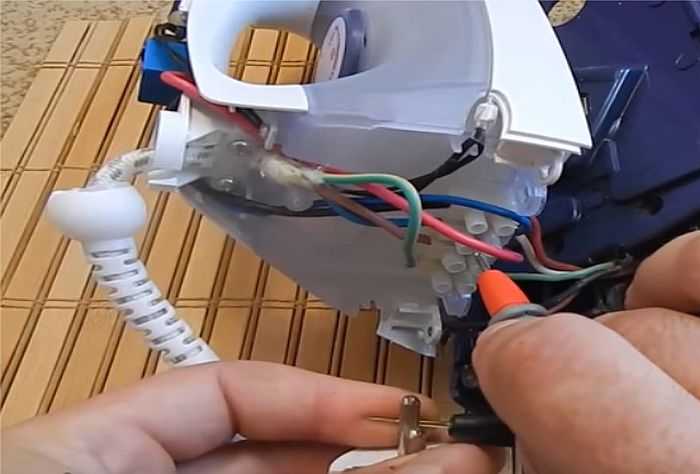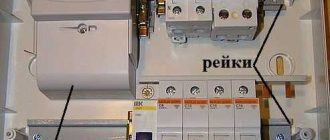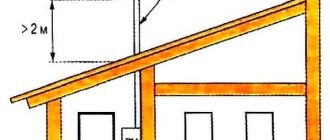If the iron stops heating, you can buy a new one, but often the damage is not very serious and can be repaired yourself. If you know how to work with a screwdriver and a multimeter, you will cope. About how to repair the iron with your own hands and we will tell you in this article.
Περιεχόμενα του άρθρου
General device
Since irons are produced by a lot of different companies, they are slightly different – shape, heating speed, quality of parts, etc. But here the general device remains the same. There is:
- A soleplate with a TEN built into it. If there is a function of a steamer, the soleplate has a certain number of holes for steam output.
- A thermostat with a knob that allows you to set the desired soleplate heating temperature.
- A tank/reservoir for the water that is used during steaming.
- There is a nozzle for splashing water, forced steam output. There is also a steam intensity regulator. With its help, the frequency of automatic supply of vaporized water is set.
- The iron is connected to the network by means of an electric cord, which is attached to the contact block, located in the rear part under the plastic cover.
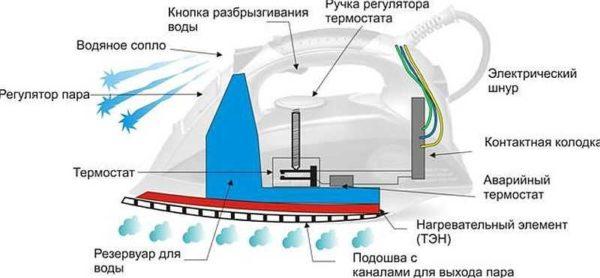
After you have familiarized yourself in general terms with what is where, you can start repairing the iron with your own hands.
What will be needed for the work
To work, you will need a set of screwdrivers – cross and flat. You will need a wide knife or unnecessary plastic card – to undermine the parts of the iron with latches. To check the integrity of parts will need a multimeter (how to use it read here). You may also need a soldering iron – this is if you have to change some parts.
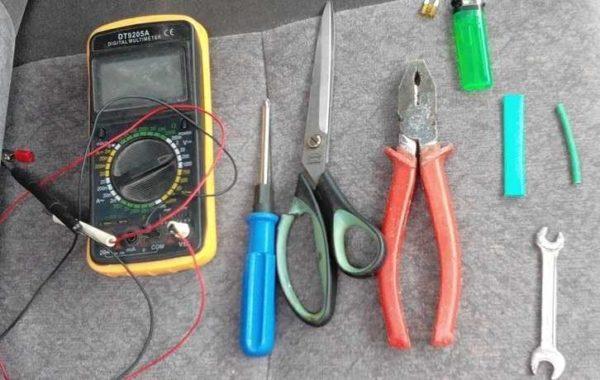
From the tools all, but in the process of work sometimes you need duct tape or heat-shrink tubing, you may need sandpaper, pliers.
How to disassemble the iron
The first difficulty faced by those wishing to repair the iron on their own is disassembly. It is far from simple and not obvious. The easiest thing to do is to remove the back panel. There are several screws that are visible and unscrew which are not difficult. In addition to the screws there may be latches. So, having unscrewed all visible fasteners, we undermine the cover with a screwdriver tip or an old plastic card and separate the cover from the case.
Under it is found a terminal block to which the cord is attached. If there are problems with the cord, you can continue the iron is not to disassemble. But if the cord is all right, you will have to disassemble further, and this may cause problems.
In some irons – Philips (Philips), Tefal (Tefal) under the cover there are more bolts. They are also unscrewed. In general, if we see the fasteners, it is removed.
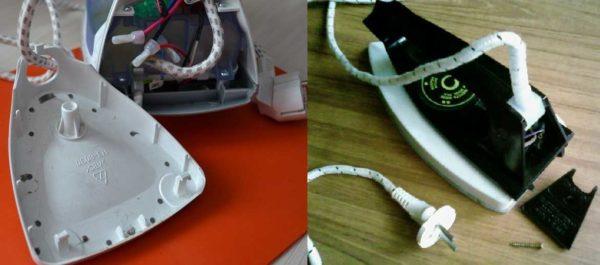
Each manufacturer develops its own design, and it often changes from model to model. That’s why there are difficulties. But there are a few points that are found in almost all manufacturers.
Immediately remove the disk of the temperature regulator and steam supply buttons, for which they must be clamped in your fingers and pulled upward. There may be latches in the buttons, so you may need something thin to be able to push them off a little – you can pry with a screwdriver.
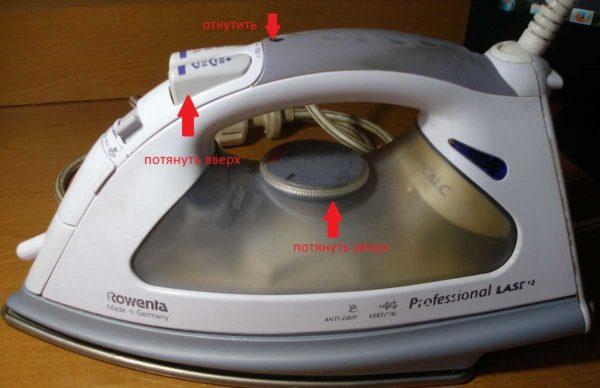
Some irons, like the Rowenta as pictured, have bolts on the handle (found on some Scarlet models). If there are such, we unscrew them. There is also a screw hidden under the removed buttons, and we unscrew it too. Then remove the upper plastic parts. They are usually fastened with snap-locks. To make it easier to remove them, you can put a knife blade or a piece of plastic (plastic card) in the lock.
Under the covers there are usually a number of bolts. Having unscrewed them, we continue disassembly until the body and soleplate are separated. Unfortunately, it is impossible to give more precise recommendations – there are too different designs. What can be advised is to proceed slowly and carefully. And a few videos on how to disassemble irons of different brands.
Power cord
Failure of the power cord is a fairly common type of breakdown. With such damage, the iron may not turn on at all or work intermittently, the soleplate may not heat up well. The cord may bend, curl, the insulation is damaged in the place of bending, some wires may fray completely or partially. If there is such damage, it is better to replace the cord, regardless of whether it is the cause or not. In any case, all places with damaged insulation should be insulated.
In case of any damage, any repair of the iron starts with checking the cord. To accurately determine whether it is in normal condition or not, it must be dialed. To do this, it is enough to remove the back cover. The terminal block, to which the cord is connected, will become available. You will need a tester or multimeter. We put it in the dial test mode, one probe is pressed to one contact of the plug, the second touches one of the wires on the block. When touching the “correct” wire, the multimeter should emit a squeak. This means that the wire is intact.
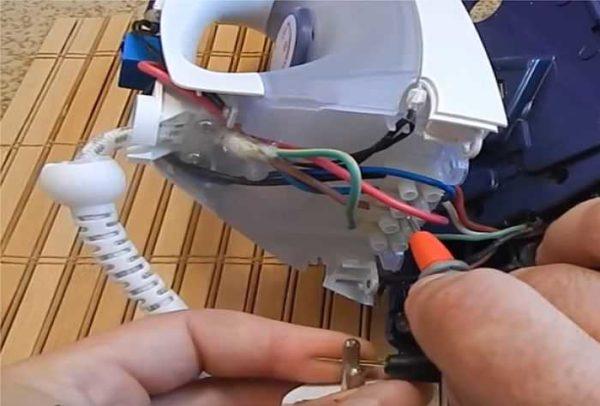
The color of the insulation of the conductors can be any, but yellow-green is necessarily ground (it should be checked by placing the probe on a small metal plate at the bottom of the plug). The other two are connected to the pins of the plug. One of these two wires should ring with the pin to which you pressed the multimeter probe. Repeat the same operation with the other pin.
For full confidence in the serviceability of the cord, it should be crumpled/twisted during ringing. Especially in those places where there are problems with insulation. If the beeping from such actions is interrupted – it is better to replace the cord. It is also subject to replacement if one or both pins “do not ring”. Perhaps you will be lucky and further repair of the iron you will not need.
Checking the performance of the heating element
If the iron does not heat up at all, it is possible that the heating element is burnt out. If this is the case, it is worth buying a new iron, as the replacement will cost almost the same amount. But first of all, you need to make sure that it is the TEN that is to blame.
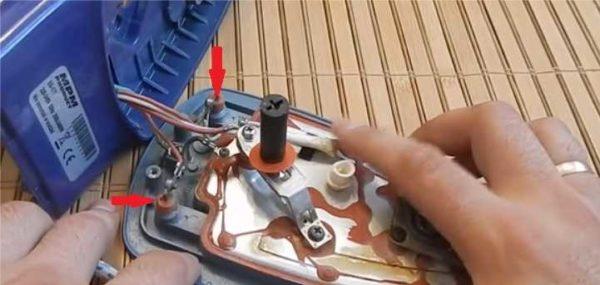
In order to check the TEG, we get to the very soleplate of the iron. On it, closer to the back, there are two outputs of the heating element. We move the multimeter to the position of resistance measurement (up to 1000 ohms), make measurements. If the numbers on the display are about 25o Ohm, then the heating element is normal, if more – burned out. As we have already said, in the case of burnout TEN repair the iron is not worth it – it is more profitable to buy a new one.
Check the thermoregulator
Thermoregulator looks like a plate with a group of contacts and a sticking plastic pin, on which a disk is then put on.
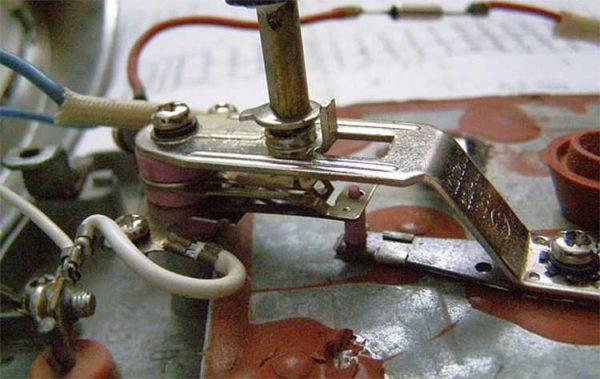
There are two contacts approaching the plate. On them, we put the probes of a multimeter and check the operability (conductivity). In the “off” position, the sound of the multimeter should disappear, when you turn it on and turn it to any position, it should continue to sound.
Damage may be that in the “on” position there is still no contact – then the iron does not heat at all. It could be the other way around – it does not turn off with the regulator and/or does not respond to the position of the regulator. Both causes are in the contacts. And, most likely, they are burned.
In the first case, there may be soot, which can be removed by putting a piece of fine-grit sandpaper between the contacts and “rubbing” the contacts a couple of times. If there is no sandpaper, you can use a nail file, but you must be careful – the temperature settings depend on the bending of the plates. So you can not bend them too much.
In the second case – if the iron does not turn off – the contacts may have burned – fused. Repair the iron in this case is to try to disconnect them. But such a trick is rarely successful. The way out is to replace it.
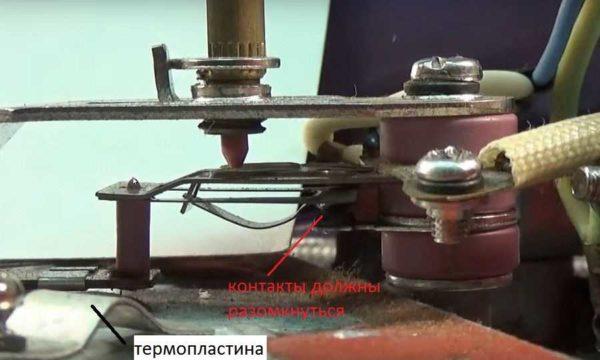
There may be another moment: when falling, the contacts could somehow mesh. When the iron soleplate heats up, the bending thermoplastic plate presses on the contact groups, but the contacts cannot open. The result is the same – the iron will not turn off when heated. Repair of the iron is also similar – we try to restore the mobility of the plates, trying not to distort them. If it does not work – change.
Checking the fuse
Approximately in the same area where the thermoregulator is located, there is a thermal fuse. It stands in case of overheating of the iron soleplate – it burns out if the iron heats up to dangerous temperatures. Usually this fuse is covered with a protective tube and most often it is white in color.
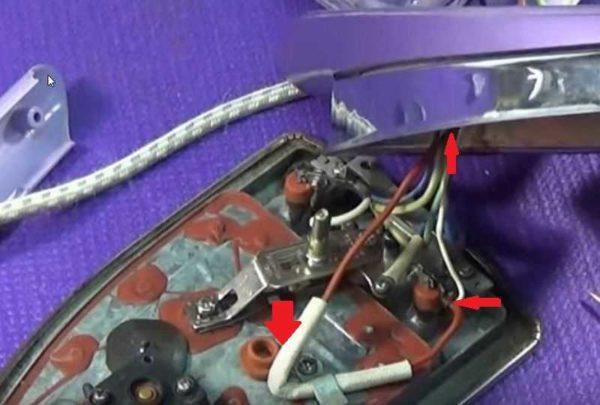
Find the pins, and wire them. In a normal state, the fuse “rings”, if blown – silence. If you want, you can move the tube, call directly – there may be a break / burnout of the connecting wire. If the fuse is blown – unsolder it, look for a similar one and install it in its place.
You should not exclude the thermal fuse from the circuit – it will protect you from fire in case of problems with the thermoregulator: it will simply burn out and the iron will not work. And even though the iron will need repair, your home will be safe.
Steam spray system
If there is almost no steam coming out of the iron, but there is water in the container, most likely the holes are clogged with salts. You can restore functionality by a simple technique. In a bowl with low sides (a pan or a baking tray will do) pour water and vinegar (ordinary, table vinegar without dyes). For a liter of water one cup of vinegar. The second recipe – for 250 ml of boiling water 2 teaspoons of citric acid. In a bowl with the prepared liquid, you lower the disconnected iron. The liquid should cover the soleplate.
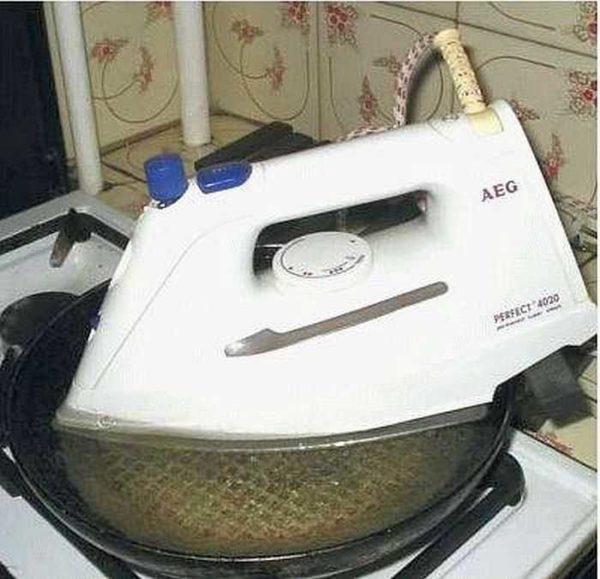
Put the container with the iron on the fire, bring to a boil, turn off. Wait until it cools down. Heat it up again. You can repeat this 3-4 times. Until the salts dissolve.
Sometimes the water stops coming out of the sprinkler. Most likely, this is due to the fact that the tube is disconnected. In this case, the repair of the iron is that it is necessary to disassemble the panel on which the injection buttons are fixed and put in place all the tubes and wires.
The second way to clean the iron from scale is to disassemble it completely, so that only one soleplate remains. Tape the soleplate with scotch tape so that water does not seep in, but you can also put it in a dish. Pour hot water with vinegar or citric acid inside the sole, soak until cool, drain, pour again. Continue in this way until you are satisfied with the result. Afterwards rinse with water and collect.

